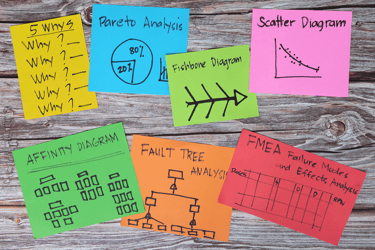The Packaging Industry's Sustainability Challenge: Why ERP Systems Are Essential for Success A straightforward guide to navigating sustainability regulations across folding carton, flexible...
How label converters can implement prepress workflow automation
In today’s fast and evolving market, the pressure to reduce costs, increase efficiency, and still deliver high-quality outputs is greater than ever.
Within this landscape, businesses that delay embracing automation risk falling behind and missing the opportunity to seize the opportunity presented by a sizable sector. Meanwhile those that adopt technology will see significant competitive advantages.
To capitalize on this shift, businesses should stay informed about the evolving landscape, recognize the most impactful areas for automation, and invest strategically to realize the greatest benefits. For companies within the label printing sector, prepress workflow automation offers a path to increased efficiency and improved profitability.
TL;DR
Prepress workflow automation for label converters can boost efficiency by streamlining operations and reducing errors. Implementing prepress automation involves several key steps, including assessing your current workflow, selecting the right software, integrating with existing systems, and training your team; however, by reducing manual tasks and automating repetitive processes, label converters can see improved profitability.
Contents
- What is prepress workflow automation?
- Where to start?
- Steps to ensure a successful implementation
- Potential challenges and how to overcome them
- Planning for continuous improvement
- Future trends in prepress automation
- How Paxis can help label converters get started with prepress automation
What is prepress workflow automation?
Prepress workflow automation refers to the use of technology to streamline the repetitive and/or manual tasks involved in preparing files for printing. In the label printing industry, automation helps manage critical stages like file preparation, proofing, and color management; minimizing manual intervention and reducing errors.
This accelerates production processes and ensures higher accuracy. As the demand for faster, more efficient production has grown, automation has become a critical component of staying competitive.
Where to start?
Before jumping into automation, it’s essential to have a comprehensive understanding of your current prepress workflow. Understanding your current strengths and weaknesses will provide a solid foundation for making the most of your automation investments.
Begin by mapping out each step in the process, from receiving files to final approval before production. This helps you identify where bottlenecks occur, where errors are most frequent, and which tasks consume the most time. By pinpointing these areas, you'll have a clearer idea of which processes to automate first.
Steps to ensure a successful implementation
1. Choosing the right automation software
The first step in a successful implementation is selecting the right software. There are providers specifically designed for label printing. These tools automate crucial tasks like file preparation, proofing, and color management out of the box. When choosing software, ensure that you are procuring a solution from an organization with a proven track record in the industry, that can scale with your business and aligns with where you are on your automation journey.
2. Seamless integration
Integrated systems reduce manual data entry, lowering the risk of errors when transferring job information between systems. Once the right software is selected, it's essential to integrate it smoothly with your existing systems, such as your ERP or MIS software. This ensures your entire workflow, from order intake to production, remains aligned and efficient.
3. File preparation automation
File preparation is one of the most time-intensive stages of the prepress process, especially in label converting, where precision is crucial for ensuring high-quality output. Automating this task can significantly reduce the time spent on manual file checks, corrections, and adjustments.
Automation tools can detect issues like incorrect formats, missing fonts, or improper bleeds, ensuring that files are ready for production without human intervention. For label converters, this not only improves production speed but also reduces costly errors, allowing for more efficient and accurate label printing.
4. Automating proofing and color management
Automation doesn’t stop at file preparation. Proofing and color management are two other key areas where automation can significantly improve efficiency. Automated proofing software checks files against design specifications, speeding up approvals and reducing back-and-forth between printers and clients.
Color management automation ensures consistent color quality across different substrates and print runs, a critical factor for maintaining brand integrity.
5. Security and data protection
Security should be a top priority when choosing an automation solution, ensuring that both production efficiency and data integrity are maintained.
With the growing reliance on cloud-based ERP systems and data sharing in prepress automation, securing sensitive information is more important than ever. Implementing strong data protection measures, such as encryption and secure client portals, ensures that files remain protected during the proofing and approval processes.
6. Training
No matter how sophisticated your automation tools are, they won't be effective without proper staff training and user adoption is key. Staff working within independent and growing label converters may feel hesitant about adopting new technology, so it's crucial to ensure that your team is comfortable using the new tools and understands how automation fits into the overall production flow and benefits their role. Organizing simple, user-friendly training sessions tailored to their experience level will help them adapt quickly without feeling overwhelmed.
Ensuring smooth adoption is key to reaping the full benefits of automation, allowing you to focus on growth, allocating resources effectively in the business and freeing up staff from manual tasks.
Potential challenges and how to overcome them
While the benefits of prepress workflow automation are clear, there are some obstacles to identify and understand - by doing this you will know how to avoid and overcome them.
1. High upfront costs
One of the most common perceived barriers to automation is the initial investment required, which for smaller businesses can seem overwhelming. However, it’s important to consider the long-term growth opportunities that embarking on a digital transformation journey will bring, and a SaaS provider might be able to alleviate any concerns around time to value for any investment.
Automation leads to reduced labor costs, fewer errors, and faster turnaround times; with a quickly deployable solution, return on investment (ROI) can be delivered almost immediately and grow over time as your business grows.
| Solution: Start small by automating the most labor-intensive and error-prone processes first. This phased approach allows businesses to spread the investment and see quick wins that can help justify further automation efforts. |
2. Resistance to change
Employees may resist automation out of fear that it will lead to job cuts or because they’re simply uncomfortable using new technology. This resistance can slow down the adoption process and prevent companies from realizing the full benefits of automation.
| Solution: Focus on training and communication. Involve your team early in the decision-making process and highlight how automation can make their jobs easier by eliminating repetitive tasks. |
3. Integration issues
Integrating new label automation software with existing systems such as ERP or MIS software can be complex. Businesses often struggle with ensuring that different systems communicate seamlessly, which can lead to workflow disruptions.
| Solution: Work closely with your software provider/s to ensure the automation tools are compatible with your existing systems. Test integration thoroughly before full-scale implementation to identify and resolve any issues. |
4. Maintaining consistent quality
While automation can significantly improve efficiency, there’s always the concern that it might compromise the quality of output. Without proper oversight, automated processes can lead to errors that go unnoticed.
| Solution: Set up quality control checks within the automation process itself. Regularly monitor the performance of automated systems and adjust as necessary to ensure that the quality remains high. Use metrics such as turnaround time, error rates, and customer satisfaction to evaluate the success of your automation. |
Planning for continuous improvement
Prepress workflow automation should not be viewed as a one-time project, especially in label converting, where evolving customer demands and advancements in production technology are constant.
As label converters operate with a complex and evolving market, it is crucial to continually reassess and refine automated workflows to maintain high-quality output and meet tight deadlines. Since technology is always advancing, workflows must evolve as well.
With the initial automation in place, it is essential to monitor key metrics such as turnaround times, error rates, and overall production efficiency. By tracking these metrics, businesses can fine-tune workflows to reduce waste, enhance color management, and improve production speed, ensuring they remain competitive.
Future trends in prepress automation
As the printing industry evolves, future trends like artificial intelligence (AI), machine learning (ML), and advanced cloud-based solutions will likely shape the next generation of prepress automation. AI-driven predictive analytics could enable printers to anticipate bottlenecks and prevent issues before they arise, further improving efficiency and reducing costs.
How Paxis can help label converters get started with prepress automation
Paxis provides label converters with a powerful, cloud-based ERP solution that streamlines key prepress processes, helping businesses automate tasks like estimating, order management, and inventory control.
With advanced estimating tools, seamless integration with operational systems, and real-time data insights, Paxis eliminates manual errors and speeds up workflows, making it easier for converters to manage both digital and analog label production. The platform’s automation features, like business process automation and SKU-based management, ensure faster turnaround times and more efficient use of resources.
Whether you're a small or growing label converter, Paxis offers an intuitive, easy-to-deploy system that requires minimal setup and scales as your business expands.





